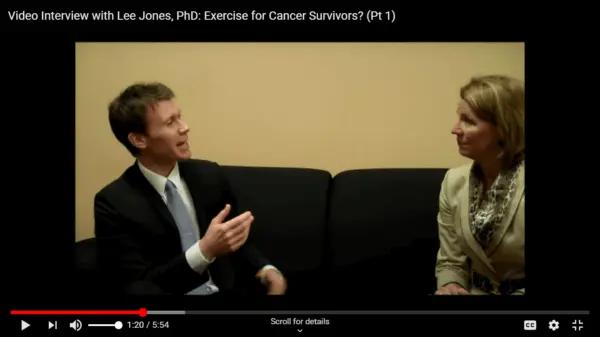
Exercise for Cancer Survivors? Part 1 of Expert Interview
Is exercise helpful for cancer survivors? Where is the research now?
Questions like these were the subject of my recent interview with an expert on physical activity in cancer survivors. Lee Jones, PhD, is Associate Professor, and Scientific Director of the Duke Center for Cancer Survivorship, at Duke University. He was at the annual conference of the Academy of Nutrition and Dietetics to provide an update on cancer survivor research.
Do you remember when people were put on bed rest following a heart attack? Not anymore! Today we know that physical activity, at a level specifically appropriate for each individual, is linked with best outcome.
- Many researchers say that cancer may represent a similar situation. Population studies tend to link physical activity among cancer survivors with better outcomes. Intervention trials are now looking at questions about what type, how much and when for optimal benefits.
- Exciting research is underway identifying potential for physical activity to prevent or minimize chemotherapy-related heart damage. Much published research is still in animal studies, and clinical studies (with people) are growing rapidly.
- Cancer-related fatigue, a deep fatigue quite different from how you feel when you’ve simply had a night with too few zzz’s, has been seen as a sign that cancer survivors may need more rest. Now, however, cancer survivors are advised to avoid inactivity.
As Dr. Jones notes in our interview, being active when you feel fatigue can seem the opposite of what makes sense, but it seems to help many people. Overdoing is not the answer, and it means finding the right balance for each individual cancer survivor. And the right balance will change at times.
We need more research to clarify how to identify the best type, amount and intensity of physical activity for individual cancer survivors at various points in their cancer journey. But this does represent a change in recommendations worthy of note.
Talk with your doctor
With all the benefits linked with physical activity in studies today, I asked Dr. Jones who should check with their doctor before beginning physical activity. His answer:
“If you’re planning a significant change in physical activity from what you’re used to, talk with your doctor.”
Dr. Jones said that applied even to those who simply plan to walk around the block, it’s a change from a normal very sedentary lifestyle.
He says that for some people, a quick check-up is all they need to know they can go forth safely. Depending on type of treatment, some may need a more thorough check to be sure that heart damage that doesn’t surface in ordinary life won’t pose risk with exercise.
Co-author of a journal article advising doctors about assessing exercise risk for cancer survivor patients, Dr. Jones noted that he encouraged his father, a prostate cancer survivor on ADT (hormone treatment), to add more physical activity….But Dr. Jones also strongly encouraged his dad to get a check-up from his doctor first.
Some conditions don’t rule out physical activity, but make certain adaptations or choices advisable on a short-term basis. For more on this, check my article, What Cancer Survivors Need to Know About Physical Activity.
Here’s a news summary of the American College of Sports Medicine guidelines for cancer survivors discussing the new emphasis on exercise during and after cancer treatment.
You’ll find American Institute for Cancer Research guidelines for cancer survivors on the AICR website; scroll down for info on physical activity.
For insights on some of the important studies on this topic – and more on unique concerns of cancer survivors regarding physical activity — check my earlier article, What Cancer Survivors Need to Know About Physical Activity.
Ballard-Barbash R, et al. Physical activity, biomarkers, and disease outcomes in cancer survivors: a systematic review. J Natl Cancer Inst, 2012 Jun 6. 104(11):815-40.
Scott, JM et al. Modulation of anthracycline-induced cardiotoxicity by aerobic exercise in breast cancer: current evidence and underlying mechanisms. Circulation, 2011. 124(5):642-50.
Schmitz, KH et al. American College of Sports Medicine Roundtable on Exercise Guidelines for Cancer Survivors. Medicine & Science in Sports & Exercise, July 2010. 42( 7):1409-1426.
Burr JF, et al. Physical activity for cancer patients: Clinical risk assessment for exercise clearance and prescription. Can Fam Physician, 2012 Sep. 58(9):970-3.
Published : October 11, 2012
Tagged: breast cancer, cancer survivors, exercise, healthy habits, healthy lifestyle, Lee Jones PhD, physical activity, video interview
Meet the author/educator
I Take Nutrition Science From Daunting to Doable.™
As a registered dietitian nutritionist, one of the most frequent complaints I hear from people — including health professionals — is that they are overwhelmed by the volume of sometimes-conflicting nutrition information.
I believe that when you turn nutrition from daunting to doable, you can transform people's lives.
Accurately translating nutrition science takes training, time and practice. Dietitians have the essential training and knowledge, but there’s only so much time in a day. I delight in helping them conquer “nutrition overwhelm” so they can feel capable and confident as they help others thrive.
I'm a speaker, writer, and nutrition consultant ... and I welcome you to share or comment on posts as part of this community!


